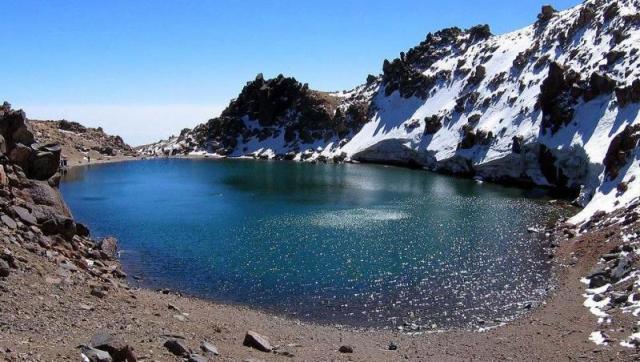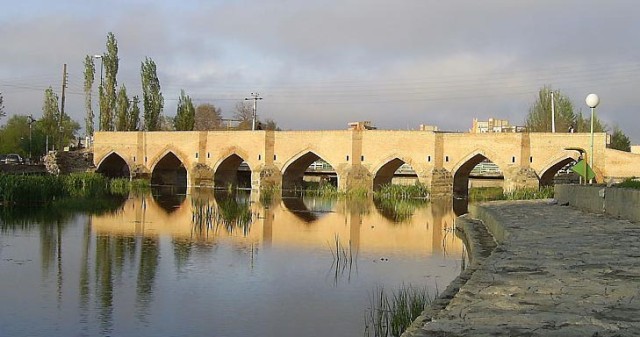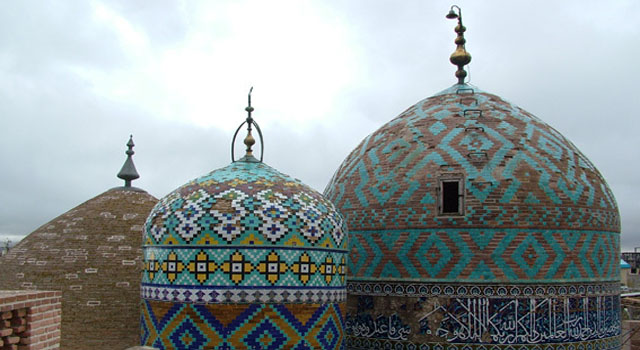|
Introduction of
Ardabil
province
-
City
of Ardabil
Page
for
easier
access to
our
visitors,
is a
bookmark.
Click
here
to
go
to
any
destination
on
the
same
page
to
move into
the
desired
destination.
Introduction Of
Ardabil
Province
-
City
Of Ardabil
Ardabil
(Persian and Azerbaijani: اردبیل ) is a historical city in north-western
Iran. The name Ardabil probably comes from the
Zoroastrian name of "Artavil" which means a holy place.
Ardabil is the center of Ardabil Province. Its
population is estimated to be around 412,669 (2006) ,
the dominant majority of whom are ethnic Azerbaijanis.
Notable for its silk and carpet trade tradition, the
ancient Ardabil Carpets are considered some of the best
of the classical Persian carpet creations. Ardabil is
also known as the seat of a World Heritage Site: the
sanctuary and tomb of Shaikh
Safî ad-Dîn,
eponym of the Safavid Dynasty.
Location
(up)
Ardabil is about 70 km from the Caspian Sea, 210 km from
the city of Tabriz. It has an average altitude of 1263 m
and total area of 18.011 km².
Neighboring on the Caspian Sea and the Republic of
Azerbaijan, this city is of great political and
economical significance.
The province of Ardabil has been blessed with splendid
natural beauty and numerous sights.
It is located on an open plain 1,500 m above sea level,
just east of Mount Sabalan (4,811 m), where cold
spells occur until late spring.
History
(up)
The province is believed to be as old as the Achaemenid
(ca. 550–330 BC). It is mentioned in the Avesta, where
prophet Zoroaster was born by the river Aras and wrote
his book in the Sabalan Mountains. During Parthian era
the city had a special importance among the cities of
Azarbaijan. Some Muslim historians attribute foundation
of Ardabil to king Peroz I of Sassanid Empire. The
Persian poet Ferdowsi also credits the foundation of the
city to Peroz I. Ardabil suffered some damages caused by
occasional raids of Huns between 4th to 6th century AD.
Peroz repaired those damages and fortified the city.
Peroz made Ardabil the residential of provincial
governor (Marzban) of Azarbaijan.
During the Islamic conquest of Iran, Ardabil was the
largest city in North Western Iran, and remained so
until the Mongol invasion period. Ardabilis fought the
Mongols three times, however the city fell after the
third attempt by Mongols. They massacred not only the
Ardabilis but inhabitants of neighboring villages and
killing everyone they could find. Incursions of Mongols
and Georgians left the city in ruins for nearly three
centuries til the advent of Safavids.
Safavid Shah Ismail I started his campaign to
nationalize Iran's government and land from here, but
consequently announced Tabriz as his capital in AD 1500.
Yet Ardabil remained an important city both politically
and economically until modern times. She was sacked by
Ottomans 14 times between 1514–722 and in 1915 and by
Russians in 1813, 1828 and in 1916.
On 28 February 1997, a destructive earthquake hit the
Ardabil area. At least 965 people were killed, 2,600
injured, 36,000 homeless, 12,000 houses damaged or
destroyed and 160,000 livestock were killed. Severe
damage was observed to roads, electrical power lines,
communications and water distribution systems around
Ardabil.
Climate
(up)
Cold
and semi-arid (Köppen BSk), many tourists
come to the region for its relatively cool climate
during the hot summer months. The winters are long and
bitter cold, with a temperature plummeting to -25 °C.
The annual rainfall is around 380 mm.
|
Climate data for Ardabil |
|
Month |
Jan |
Feb |
Mar |
Apr |
May |
Jun |
Jul |
Aug |
Sep |
Oct |
Nov |
Dec |
Year |
|
Average high °C (°F) |
3.0
(37.4) |
4.5
(40.1) |
9.3
(48.7) |
16.7
(62.1) |
19.7
(67.5) |
23.2
(73.8) |
25.0
(77) |
24.7
(76.5) |
22.6
(72.7) |
17.5
(63.5) |
11.4
(52.5) |
5.7
(42.3) |
15.28
(59.5) |
|
Average low °C (°F) |
-7.9
(17.8) |
-6.3
(20.7) |
-2.4
(27.7) |
2.8
(37) |
6.0
(42.8) |
9.0
(48.2) |
11.6
(52.9) |
11.6
(52.9) |
8.7
(47.7) |
4.8
(40.6) |
0.3
(32.5) |
-4.6
(23.7) |
2.8
(37.04) |
|
Precipitation
mm (inches) |
24.7
(0.972) |
21.8
(0.858) |
37.4
(1.472) |
38.3
(1.508) |
45.1
(1.776) |
19.4
(0.764) |
6.7
(0.264) |
5.4
(0.213) |
9.9
(0.39) |
33.0
(1.299) |
37.1
(1.461) |
25.1
(0.988) |
303.9
(11.965) |
|
Avg. precipitation days |
8.0 |
8.5 |
11.2 |
11.5 |
13.7 |
6.9 |
3.9 |
3.8 |
5.8 |
8.8 |
7.5 |
7.7 |
97.3 |
|
Source: World Meteorological Organisation (UN)
|
Demography
(up)
Population (Metropolitan): about 650,000
Religion: Mainly Shi'a Islam
Ethnicity: Mostly Azeris
Language: The majority of the population speaks
Azerbaijani, however, most of Ardabil's population
could understand and speaks Persian as well.
Attractions
(up)

Sabalan
Mountain
Peak

Yeddi goz bridge (Seven eyes bridge)

Sheikh Safi's tomb

The Mausoleums Of Sheikh Safi
|
Anthropology |
|
Attraction |
Description |
|
The complex of Sheikh Safi-ad-din Ardabili |
is a World Heritage Site, comprising the
following components: the mausoleums of Sheikh
Safi and Shah Ismail I, Chini khaneh (meaning the house
of chinaware), a mosque, Jannat Sara (meaning
the house of paradise), Khanaqah (the house of
Dervishes), Cheragh Khaneh (the house of lamps),
Shahid khaneh (the house of martyrs) and Chelleh
Khaneh (the place where devotees shut themselves
up during the forty days of Lent). The mausoleum
of Sheikh Safi, the dome of which is called
"Allah-Allah" has an octagonal interior. |
|
Masjid Jameh |
Ruins of once magnificent and unique Mosque. |
|
Mirza Ali Akbar mosque and school |
This comlex dates back to Qajar period |
|
Ardabil bazaar |
This beautiful Persian
bazaar was built during Safavid period and in
addition to main bazaar hall with open vaults has a hammam and a small yet
mystifying mosque. |
|
Ardabil bridges |
Ardabil host numerous
historical bridges namely Pol-e Gilandeh,
Pol-e Nayer, Pol-e Haft Cheshmeh,
Pol-e Panj Cheshmeh and Pol-e She
Cheshmeh and Qarah Soo Bridge, most
were built during Safavid era. |
|
Ardabil bridges |
Ardabil host numerous historical bridges namely
Pol-e Gilandeh, Pol-e Nayer, Pol-e Haft Cheshmeh,
Pol-e Panj Cheshmeh
and Pol-e She Cheshmeh and Qarah Soo
Bridge, most were built during Safavid era. |
|
Imamzadeh Saleh mausoleum |
The mausoleum of Imamzadeh
Saleh who is a descendant of a Shia Imam was built 250 years
ago. |
|
Saint Mary church |
This Armenian orthodox
church has a beautiful wooden main door and
painted dome built in 1876. |
|
mausoleum of Sheikh Jebra'il |
located 2 km north of Ardabil |
|
old but always lively bazaar |
|
|
babadavood anbaran |
Friday mosque |
and a few ancient bridges. In addition to these, in many
villages of Ardabil, relics of ancient monuments,
including tombs have been found.
Being a city of great antiquity,
the origins of Ardabil go back 4000 to 6000 years
(according to historical research in this city). This
city was the capital of Azerbaijan province in different
times, but its golden age was in
the Safavid period.
Geology
(up)
Many hot springs and beautiful natural landscapes are in
Ardabil and around which attract tourists. The mineral
springs of Ardabil (Beele-Darreh, Sar'eyn, Sardabeh and
Booshloo) are notable throughout Iran for their
medicinal qualities.
Many beauty lakes: the largest of
which are Ne'or,
Shorabil, ShoorGel,
NouShahr and Aloocheh that are the habitats of some
species of water birds. The beautiful Lake Ne'or is
located in a mountainous area 48 km south-east of the
city of Ardabil. It covers an area of 2.1 km² and has an
average depth of 3 metres. It is fed by springs in the
lake bed.
|
Attraction |
Description |
|
Lake
Shorabil |
located in a hilly area south of the city of
Ardabil and covers an area of 640,000 m². The
surface of the lake is covered with a thin white
layer of minerals, being useful for healing skin
diseases and rheumatism. Near the lake there is
the leisure complex of Shorabil. |
|
Baliqly Chay River |
Meaning "a river with many fish" in Azarbayjani
language, this river originates from the Sabalan
Mountains and passes through Ardabil city. As a
result, many villages and townships have settled
around this river. It also irrigates much of the
agricultural lands in this province. |
|
Sabalan (Savalan) mountain |
Sabalan (Persian:
سبلان
Sabalân;
also called Sāvālān) is an inactive
stratovolcano in Meshkinshahr Ardabil province
of northwestern Iran about 20 miles west of
Arbadil. Sabalan is the third highest mountain
in Iran and a permanent crater lake has formed
at the summit. Sabalan has a ski resort
(Alvares) and different tourist areas such as
the Sarein spa. The mountain is known for its
beautiful vistas, including the Shirvan gorge,
where few climbers ever venture. |
Colleges and
universities
(up)
-
Ardabil University of Medical Sciences
-
Mohaghegh Ardabili University
-
Islamic Azad University of Ardabil
-
Payam Noor University of Ardabil
-
Soureh University of Ardabil
-
Islamic Azad University of Khalkhal
Economy
(up)
The economy of Ardabil is partially agricultural,
partially tourist based, with some industries in
operation.
The Iranian government in 2006 announced plans to build
"the largest textile factory of its kind in the Middle
East" in Ardabil.
Arta Industrial Group (AIG) has one of the largest
textile conglomerates in Iran, which is located in the
provinces called Qazvin and Ardabil. The group has
received numerous awards for being one of the top 20
exporters and industrial groups in Iran since 1998. It
is the first company to produce high-density fiberboard
(HDF), medium-density fiberboard (MDF), laminate
flooring and multi-layer
films in Iran.
AIG has the first private industrial site in Iran in the
city of Ardabil, which has fifteen main factories owned
by (AIG). This Industrial zone covers an area of 100
hectares and Residential Area for engineers and managers
of the company.
The town has an airport
Notable people from Ardabil
Arts and music
(up)
-
Javad Alizadeh, cartoonist.
-
Nasrollah Nasehpoor, singer in Iranian classical
vocalists.
-
Rubaba Muradova, opera, folk singer Maqam.
-
Clergy and religious
(up)
-
Abdolkarim Mousavi Ardabili, Iranian politician.
-
Rahim Moazzen Zadeh Ardabili, son and successor of
Abdul Karim Moazzen Zadeh Ardabili, recorded his
Azaan in 1955
-
Safi-ad-din Ardabili, Spiritual leader in 13th
century.
-
Sadegh Khalkhali, Iranian
Islamist
Poets and writers
(up)
-
Baba Safari, historian.
-
Madina Gulgun, Azerbaijani poet.
-
Mir Jalal Pashayev, writer and literary critic.
-
Sadrol Mamalek Ardabili,
writer.
Politicians and
reformers
(up)
Babak Khorramdin, ancient revolutionary leader
fighting the Abbasid Caliphate in Iran.
Ismail I, founder of the Safavid dynasty.
Jafar Pishevari, founder and
chairman of separatist and communist Azerbaijan
People's Government, created and supported by
Soviet
occupational forces in north-western Iran.
Rahman Dadman, former Minister of Roads and
Transportation of Iran.
Sayyid hossein Ardabili, member of Demokrat party in
Tehran and Mashhad.
Sport
(up)
-
Rahim Aliabadi, Men’s Greco-Roman Wrestling.
-
Ali Daei, football player.
-
Hossein Rezazadeh, weightlifter and the current
world record holder in the sport.
-
Yahya Golmohammadi, football player.
-
Karim Ansarifard, youngest
football player in Team Melli Iran to score the most
goals.
|